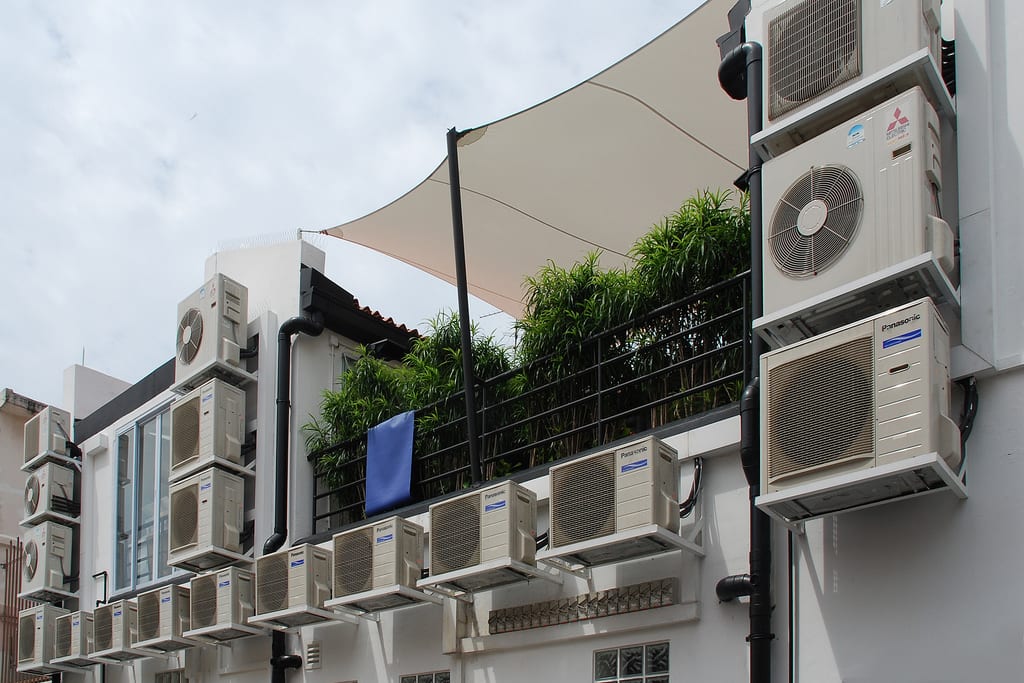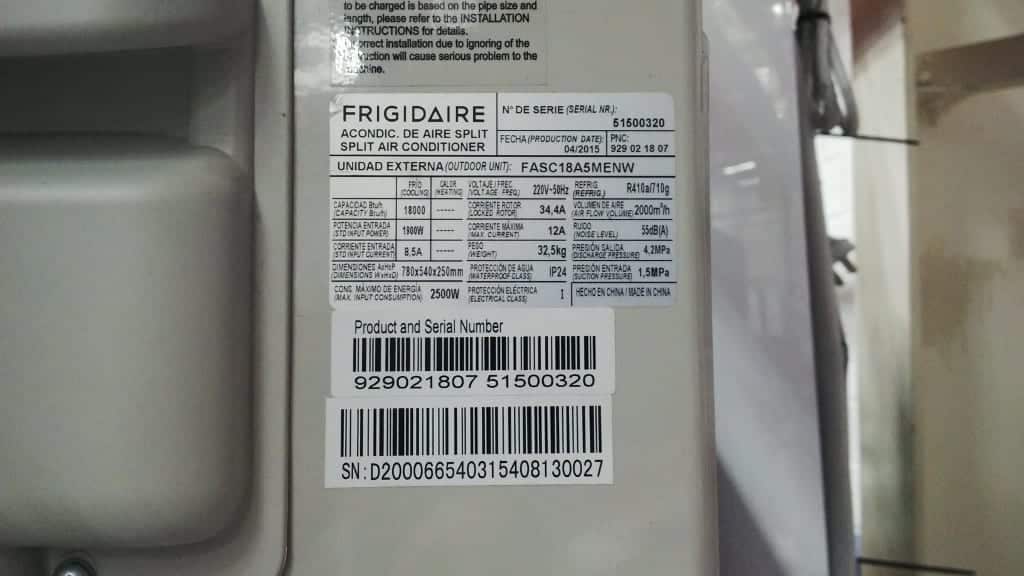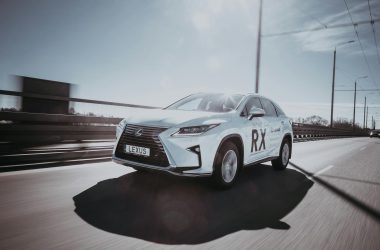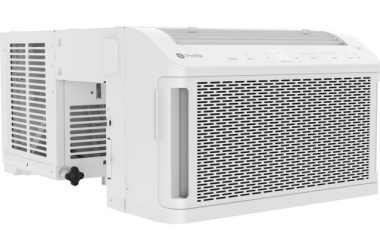Air conditioner power consumption trumps that of most appliances. The power consumption of air conditioners averages 318 watts (for a 24,000 BTU unit) in most American households. That 318-watt average (source: U.S. DOE) adds up to 228 kWh per month. That would cost:
Currency: USD.
- $27.36 at an electricity rate of $0.12/kWh (this is the average electricity rate in the U.S.).
- $45.60 (€41.87) at a rate of $0.20/kWh. $0.20 is a common rate in Europe (many European countries are in the range of $0.19 to $0.25/kWh).
- $79.80 at a rate of $0.35/kWh.
- $102.60 at a rate of $0.45/kWh.

Please note that air conditioner energy usage is heavily influenced by the temperature of your environment and your thermostat temperature. It varies significantly by country.
The power consumption of air conditioners is determined by two factors: Runtime, or compressor speed. In the case of a non-inverter/single speed unit, the compressor speed remains the same at all times and the unit shuts off when the desired temperature is achieved. Power consumption is determined by the unit’s runtime in hours multiplied by its wattage.
The power consumption of inverter air conditioners can be controlled in real time because increasing the thermostat temperature decreases compressor speed, thereby reducing power consumption immediately. To determine the average power consumption of your own air conditioner, you can plug it into an energy use meter.
- How To Determine Air Conditioner Efficiency.
- Effect Of Air Conditioner Size On Power Consumption.
- Power Consumption Of Air Conditioners Ordered By Unit Size.
- Power Consumption Of 5,000 BTU Air Conditioners.
- Power Consumption Of 9,000 BTU Air Conditioners.
- Power Consumption Of 12,000 BTU Air Conditioners.
- Power Consumption Of 18,000 BTU Air Conditioners.
- Power Consumption of 24,000 BTU Air Conditioners.
- Power Consumption Of 28,000 BTU Air Conditioners.
- Reducing Air Conditioner Energy Usage.
- Inverter Air Conditioners Vs Standard Units.
How Does One Determine The Efficiency Of An Air Conditioner?
Fortunately, room air conditioners come with an EER rating. EER means Energy Efficiency Ratio. The EER is the ratio of an A/C unit’s cooling capacity to its wattage. Therefore, a 24,000 BTU [PDF] unit with an EER of 10 draws 2,400 watts (24000 / 2400).
Due to the exceptionally high power consumption of air conditioners, it’s ideal to aim for a unit with an EER above 11. These are easy to find.

Of all the electrical ratings printed on the label above, the only one relevant to your electric bill is the one marked ‘STD INPUT POWER’. That is the unit’s wattage.
The unit won’t draw as much as the locked rotor current unless it fails to start (due to a locked rotor, that is), and the ‘MAX. INPUT CONSUMPTION’ is the initial startup power consumption. It won’t draw this much current for more than a few seconds, and is therefore irrelevant to your electric bill.
The Capacity Btu/h rating is just the unit’s cooling capacity, measured in BTUs. It indicates that this is an 18,000 BTU unit. We can now conclude that the EER of this unit is 9.47 by dividing the BTU/h rating (18,000) by the standard power input rating (1900). This is common, but not the best. Remember, a higher EER is better!
For environmental reasons, ensure that the refrigerant (marked ‘REFRIG’ on this unit) is R410a, and not R-22, as R410a won’t cause ozone layer depletion. Almost all new household air conditioners use R410a, so they are easy to find.
Effect Of Unit Size On Air Conditioner Power Consumption
In some cases, very large units have a slightly lower EER (this means that they use more energy) than the average unit. However, smaller air conditioners may end up costing you more due to common habits.
Small units take long to cool off, so you may be reluctant to turn them off because you won’t want to wait for them to cool back off later (this is a terrible waste of energy). To avoid waiting, people often buy larger units (24,000 BTU for 200 square-foot rooms, for example).
Power Consumption Of Air Conditioners – Ordered By Unit Size
Power Consumption Of 5,000 BTU Air Conditioners
5,000 BTU air conditioners are not the smallest on the market, but units under that are uncommon and I would not recommend them. 5,000 BTU air conditioners are recommended for rooms less than 200 square feet (ideally less than 150 square feet). Up to 250 square feet if it is a 6,000 BTU unit.
The wattage of 5,000 BTU air conditioner units averages 446 to 580 watts (most of the units assessed for this average were window units, as 5,000 BTU split units are uncommon).
Power Consumption Of 9,000 BTU Air Conditioners
The power consumption of 9,000 BTU air conditioner units ranges from 800-900 watts (if a 9,000 BTU A/C unit consumes more than 900 watts, it is inefficient and you should look for a better model). 9,000 BTU A/C units are recommended for rooms that are 350-400 square feet (this average applies to both window and split units).
If you’re interested in purchasing a 9,000 BTU unit for a 350-400 square foot room, you can feel free to help yourself to a 12,000 or even 24,000 BTU unit instead, as these will cool your room quicker.
They will not incur a significantly higher electricity cost than smaller units because they don’t need to run as long as the smaller ones (in this case, i’m assuming that you’ll purchase an inverter model). The average energy usage of 24,000 BTU air conditioners is slightly higher because they provide fewer BTUs of cooling capacity per watt of energy consumed.
Power Consumption Of 12,000 BTU Air Conditioners
12,000 BTU air conditioner units consume 1,061 (EER: 11.3) to 1,333 watts (EER: 9, which is a bit low by today’s standards). An EER of 11.3 is average for new 12,000 BTU window units, translating to a wattage of 1,061 watts.
Please don’t buy less than 11.3 (in other words, don’t buy anything with a wattage over 1,061 watts). A/C units with an EER of 11.3 are so common that you won’t have any trouble finding them. Your wallet will thank you later.
12,000 BTU units are recommend for rooms ranging from 450-550 square feet.
Power Consumption Of 18,000 BTU Air Conditioners (1.5 Tons/5.2 kW)
The average power consumption of 18,000 BTU air conditioners is 185 kWh per month.
There are uncommon air conditioner sizes in the 12,000 to 18,000 BTU range, including 13,000 BTU, 14,000 BTU, 15,000 BTU, and room size calculations sometimes yield results that don’t match any unit (or extremely rare units) on the market (such as 16,000 BTU).
In such cases, your installer might recommend a slightly (or even considerably) larger unit (such as an 18,000 BTU unit) if that’s all they can find.
The power draw/wattage of 1.5 ton air conditioners typically ranges from 1,470 watts to 1,614 watts, and have EERs ranging from 11 to a little over 12.
Always remember that this isn’t the units’ cumulative power consumption, this is the wattage (if they are operating at their maximum settings. i.e. their lowest temperature setting and highest fan setting). The EER is normally printed on the yellow energy label, if any.
Always go for the best! EERs in the 12 range aren’t too hard to find, so buy air conditioners with an EER exceeding 12. The difference between 11 and 12 isn’t particularly significant, though. Be sure to get a unit that is offered with solid support (this entails buying it from a reputable store that offers free maintenance within a reasonable warranty period).
Fortunately, there are inverter air conditioners in this range, and inverter units are capable of consuming 50%-60% less energy than their non-inverter counterparts under some circumstances (your chances of saving that much increase if you’re a regular A/C user).
Power Consumption Of 24,000 BTU Air Conditioners
Unfortunately, 24,000 BTU A/C units are a little less efficient than their smaller counterparts, with an EER range of 8.5 to 9.6 for new units (this applies to both split and window units). They typically draw 2,500 to 2,823 watts. Despite their relatively-low efficiency, these units are among the most widely used because they cool rooms very quickly.
For that reason, they are still a good option. People with smaller units may not want to turn them off because they might take too long to cool back off when they return. This means that the energy usage of a 24,000 air conditioner could, in practice, be lower than that of a 9,000 BTU or 12,000 BTU unit (assuming it is used in the same room).
In the United States, the power consumption of 24,000 BTU household air conditioner units averages 228 kWh/month, and these units are recommended for rooms ranging from 1,400 -1,500 square feet, but that isn’t a requirement. These units can be used in smaller rooms.
Power Consumption Of 28,000 BTU Air Conditioners (2.3 Tons/8.2 kW)
The average power consumption of 28,000 BTU air conditioners is 357 kWh per month.
28,000 BTU air conditioner units are typically in the 9-10 EER range, and the wattage of most of these units ranges from 2,800 watts to 3,100 watts. As is the case with the 24,000 BTU, the EER of these units is not the best. To be fair, larger units often have lower EER ratings than smaller ones.
28,000 BTU air conditioner units can cool rooms up to 1,900 square feet. Bear in mind that this does not include rooms in megathermal/tropical climates).
The best thing you can do efficiency-wise is to find the highest EER for the unit which matches your room best. This means that if your room needs 28,000 BTU, you should still get a 28,000 BTU unit, but just find the most efficient 28,000 BTU unit you can.
Reducing Air Conditioner Energy Usage/Cooling On A Budget
After seeing the power consumption data above, you may be concerned about the high energy usage of air conditioners, but don’t worry — This can be reduced substantially with the following tips (which are intended specifically for residential air conditioners, although they may be helpful in other cases).
Maintenance
Air conditioners have to pass air through many tiny crevices in order to operate efficiently. Ensure that your filters are clean, as well as your condenser and evaporator fins. If any of the above is dirty, airflow may be compromised.
A clogged condenser with inadequate airflow may overheat, reduce its ability to dispel heat outside (decreasing efficiency), and damage the compressor. A congested evaporator may freeze, dramatically reducing efficiency and rendering your air conditioner a paperweight. The same applies to the filters. The condenser and evaporator are not user serviceable, so it’s highly recommended that you call a contractor to clean them for you.
Inverter Air Conditioners Vs Standard Units
Standard air conditioners switch on at full speed (resulting in higher noise levels), cool the air, and then shut themselves off. You can set your thermostat temperature, so they will cycle on and off as needed to maintain that temperature.
Inverter units, on the other hand, adjust the speed of their compressors in response to cooling demand. This enables them to operate at low speeds (which results in low power consumption, and low noise levels) when cooling demand is low, and they only have to operate at full speed if the weather is exceptionally hot (or your unit is undersized, which is the most likely scenario).
You can also adjust the temperature of the room fairly quickly with inverter units, as the until will turn itself down immediately (but it will take a moment for the room temperature to change).
When An Inverter Air Conditioner Is Not Worth It
If you rarely use your air conditioner, you won’t recuperate the extra funds spent on an inverter unit easily.
Example scenarios in which a standard unit is best:
- You virtually (or actually) live at work.
- You live on a plane. Some people travel so frequently that they only go home once in a while.
When An Inverter Air Conditioner Is Worth It
In general, an inverter air conditioner will pay for itself most quickly if you normally use your air conditioner for extended time periods.
Example scenarios in which an inverter air conditioner is desirable, and most likely to pay for itself:
- You spend more than 8 hours per day at home.
- Your working hours are typical. This includes 9-5 jobs, as well as all night shifts, assuming that you’re at home in the days.
Use A Fan
Pointing a standing fan at yourself and turning up your air conditioner thermostat temperature (substantially) will help you cool down using the evaporative cooling effect that fans provide. I would recommend a standing fan which is at least 16″, but no more than 20″ to keep noise levels and power consumption down. If you don’t point the fan at yourself, it won’t be very helpful. If you don’t like having a fan blow on you all the time, set it to oscillate. The energy usage of the fans in the range I recommended is usually 50-100 watts.
Use White Curtains
White curtains can reflect a significant amount of hot sunlight back outside. Sunlight turns into heat after it enters your room, and having direct sunlight on you can make matters much worse.
Awnings
A sturdy awning installation can block quite a bit of sunlight, which would otherwise heat up your house quite a bit. This can significantly reduce the load on your air conditioner, hence lowering your electric bill.
Point The A/C Vent At Yourself
This worked incredibly well for me. If possible, pointing the A/C vent at yourself is a way to take advantage of the energy-efficient evaporative cooling effect that fans provide, and the A/C unit will dedicate a greater percentage of its capacity to cooling you, rather than wasting it on the furniture in the room. To reduce energy usage using this method, turn the thermostat temperature up.
Set The Thermostat Temperature Wisely
Increase the temperature on your thermostat as much as you can bear to. The lower it is, the longer the unit has to stay on to maintain that temperature. If you’re using an inverter unit, then the lower the thermostat temperature setting is, the faster the compressor has to pump refrigerant, increasing power consumption.
Cool Only The Areas You Need To
If you have a unit in every room, or central A/C, it may be tempting to ‘keep the house cool’, as some would put it, but that is costly. Try your best to turn on the A/C only in the room that you’re currently in, and don’t turn it on if you’ll only be in the room for a few minutes, because all that energy that went into cooling it off would go to waste.




